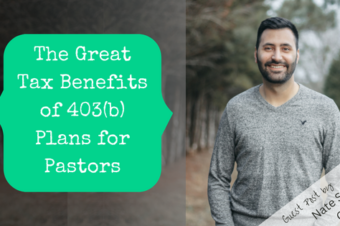
People over 50 are eligible to make extra contributions to their 403(b) plans. However, some plans even let younger people make extra contributions. Here is everything you need to know regarding eligibility, limits, etc. for making extra contributions to your 403(b).
I’ve seen a pattern lately; pastors whose kids are finally grown and on their own doubling down to maximize their retirement savings during their last 10 or so working years. It’s as if after many years of raising a family and putting others first, they finally turn their eyes to their own financial situation and get scared.
If you’re one of those pastors, don’t waste time thinking of what you could have done better in the past. That is over; all you have now is the present and the future. And no matter what you might think when you look in the mirror, you still have time.
If your church offers a 403(b) retirement plan, you’re in luck. Not only is it a tax-advantaged way to save for your future that allows you to claim a housing allowance in retirement and avoid SECA taxes, but you may be eligible to make extra tax-advantaged contributions than your church members with 401(k) plans can’t make.
403(b) Contribution Limits
The IRS limits the amount that can be saved into tax-advantaged retirement accounts. For 2022, the deferral limit for 403(b)s is $20,500. IRA contribution limits are much less at $6,000.
If you’re over 50, you are eligible to make catch-up contributions. You can put an additional $6,500 into your 403(b) and $1,000 into your IRA. You’re considered to be over 50 as long as you turn 50 at some point during the tax year. So, if your birthday is on or before December 31, 1972, you can make extra contributions for the 2022 tax year.
15 Years Of Service Catch-Up Contributions
Those contribution limits may seem high, but if you’re pushing 60 and just starting to save seriously, they aren’t nearly high enough. That’s where a special 403(b) rule may be able to help.
Some 403(b) plans are written to allow “15 years of service catch-up contributions.” That means that if you have been with the employer that sponsors your 403(b) for 15 years or more, you are eligible to make additional tax-advantaged contributions. Those 15 years of employment do not have to be consecutive.
How Catch-Up Contributions Are Calculated
If eligible to make these special contributions, you can contribute up to $3,000 a year for a lifetime total of $15,000. There is one thing you need to be aware of, though. For those over 50, any catch-up contributions made will count towards your “15 year” contributions before your “over 50” contributions.
For example, let’s say you are 55 years old, have worked for your church 20 years, and contribute an extra $3,500 to your 403(b) next year. The first $3,000 will count against your $15,000 lifetime limit for “15 year” catch-up contributions. The other $500 will count towards your permitted $6,000 “over 50” catch-up contribution.
How To Make The Most Of Your 403(b) Catch-up Contributions
Because of the way catch-up contributions are calculated, it helps to strategize a bit. If you are under 50 but have been with your employer 15 years, you may want to maximize your catch-up contributions before you turn 50. Your money will have longer to grow and then your “15 year” catch-up contributions won’t interfere with your “over 50” ones.
If you’ve already passed age 50, you’ll get the biggest advantage by maxing out both kinds of catch-up contributions the same year. If you can only afford to contribute $4,500 extra per year, it would be best to save up and contribute $9,000 every two years instead of $4,500 each year. That way, in a 2-year span you only use up $3,000 towards your lifetime “15 year” catch-up limit instead of using $6,000.
| Option 1 | Total | “15 Year” Contributions | “Over 50” Contributions |
| Year 1 | $0 | $0 | $0 |
| Year 2 | $9,000 | $3,000 | $6,000 |
| Total | $9,000 | $3,000 | $6,000 |
|
Option 2 | |||
| Year 1 | $4,500 | $3,000 | $1,500 |
| Year 2 | $4,500 | $3,000 | $1,500 |
| Total | $9,000 | $6,000 | $3,000 |
Option 2 uses up your $15,000 lifetime limit twice as fast even though you’re putting away the same amount of money both ways.
Before You Make Catch-up Contributions…
Before making extra contributions to your 403(b), check with your plan administrator to make sure your specific plan allows for it. If it does, have them calculate to make sure you are eligible to make them. Even if you’ve been with your employer 15 years, if some of those were part-time that could affect the calculations.
If you make extra contributions when you are not eligible, the plan will have to refund them to you along with any earnings. You will have to pay taxes on both the refunded amount and the earnings. Avoid the hassle and confirm your eligibility before making the contributions.
For more information on making extra contributions to your 403(b) plan consult your plan administrator or IRS Publication 571.




1 Response
Kristy Campbell
December 8, 2022just checking out your website … very helpful info…